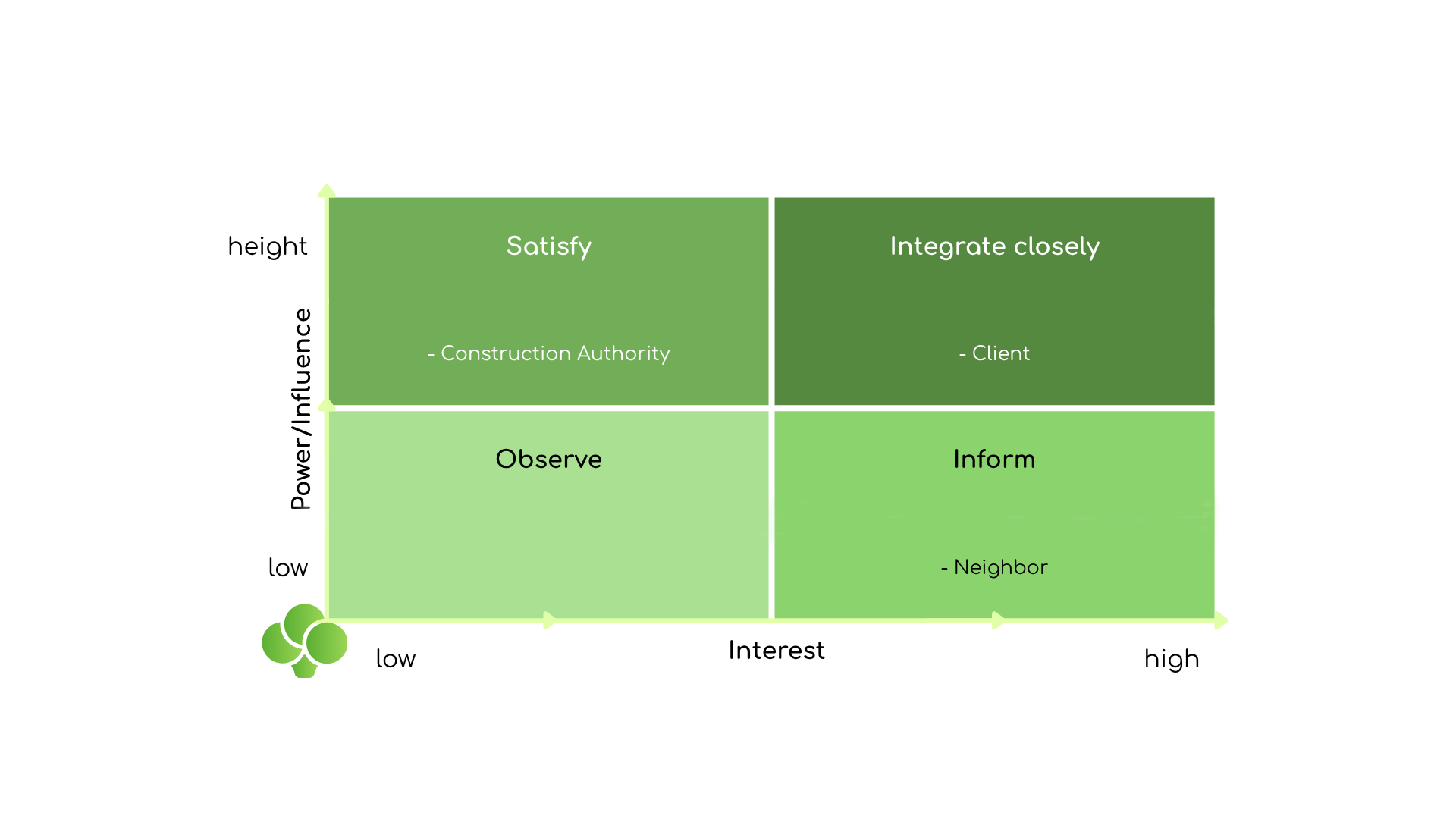Mastering Stakeholder Management with the Power-Interest Grid
Imagine this: you’re launching a new project, fueled by motivation and a clear vision. Everything is on track until you hit a snag from an unexpected source. A key stakeholder feels overlooked, and suddenly, the project’s success hangs in the balance. Sound familiar? This is precisely why underestimating stakeholder significance is a risk you can't afford. In project management, influence is power, and understanding your stakeholders is non-negotiable.
Why Stakeholders Are Your Project's Greatest Asset
In any project, large or small, stakeholders are central to your success. They shape decisions, define goals, and ultimately influence outcomes. By identifying and strategically managing them from the outset, you lay the groundwork for a seamless and successful project journey.

What Exactly Are Stakeholders?
Stakeholders are any individuals or groups affected by your project or who can influence its outcome. This circle extends beyond your immediate team to include external parties like customers, suppliers, government bodies, and investors. Internally, it includes other departments and management. In short, where there's an interest, there's a stakeholder.
Stakeholder Analysis: Your First Step to Success
Before diving into planning and execution, a thorough stakeholder analysis is essential. The objective is to identify all relevant parties, understand their interests and influence, and develop tailored engagement strategies. This analysis helps you prioritize your efforts and design communication that resonates.
Step 1: Identify Your Stakeholders
Start by brainstorming everyone who is impacted by or has an interest in your project. Think broadly, including both internal and external groups.
Tips
Collaborate with experienced colleagues on this step. It’s easy to overlook a crucial group at first glance.
Step 2: Analyze Interest and Influence
Once identified, evaluate each stakeholder's level of influence (Power) and their degree of interest in the project. A stakeholder with high power and high interest is a key player, while someone with low interest and low influence is a lower priority.
The Power-Interest Grid: A Visual Key to Success
The Power-Interest Grid (or stakeholder map) is the perfect tool for visualizing your stakeholder landscape. This simple yet powerful matrix plots each stakeholder on an XY-axis, providing a clear, at-a-glance overview of where each group stands.
Anatomy of the Power-Interest Grid
The grid consists of two axes: Interest (from low to high) on the X-axis and Power (from low to high) on the Y-axis. This divides the map into four key quadrants:
- High Power, High Interest (Manage Closely): These are your key players (e.g., CEO, project sponsor). They require your closest attention. Engage them frequently with regular updates and feedback sessions.
- High Power, Low Interest (Keep Satisfied): This quadrant includes stakeholders like department heads or regulatory bodies. They have significant influence but may not be involved in the day-to-day details. Keep them informed and satisfied, but avoid information overload.
- Low Power, High Interest (Keep Informed): This group often includes end-users or specific departments who are passionate about the project but lack decision-making power. Keep them in the loop with regular communications to leverage their support.
- Low Power, Low Interest (Monitor): These stakeholders require minimal effort. Monitor them, but don't invest significant time unless their position changes.
Real-World Example: The Power-Interest Grid in Action
Imagine you're managing a home renovation. Your stakeholders include the homeowner (High Power, High Interest), a neighbor (Low Power, High Interest), the construction firm (High Power, Medium Interest), and the local planning authority (High Power, Low Interest). The stakeholder map helps you prioritize your communication and engagement efforts for each one.

From Analysis to Action: Crafting Your Stakeholder Strategy
With your stakeholders mapped, you can now define a clear strategy for each quadrant:
- Manage Closely: Build strong relationships with these key players. Involve them in decisions and provide consistent, detailed updates.
- Keep Satisfied: Provide these influential stakeholders with concise, relevant information to maintain their support without overwhelming them.
- Keep Informed: Engage this group with newsletters, progress reports, and opportunities for feedback. Their support can be invaluable.
- Monitor: Keep a watchful eye on this group. A simple, periodic check-in is usually sufficient.
A well-defined strategy is your best defense against conflict, helping you secure buy-in and mitigate risks before they escalate.
Daily Stakeholder Management: Communication is Key
Effective stakeholder management is an ongoing dialogue. Your communication must be purposeful, transparent, and consistent. Define the right channels and frequency for your updates to keep everyone aligned and positive.
Streamlining External Stakeholder Communication
External partners like suppliers and contractors need seamless, transparent collaboration. This is where procoli Mini shines. Our software lets you integrate external stakeholders into your workflow with a simple link—no complex sign-ups required. They can access tasks, provide feedback, and share files effortlessly.
Real-Time Updates and Feedback
With procoli Mini, stakeholders receive automatic notifications for task updates. Discussions happen right where the work does, ensuring everyone stays informed. This boosts transparency, motivation, and commitment across the board.
The Power-Interest Grid in Practice: A Construction Case Study
As a civil engineer on a renovation project, you can use procoli Mini to assign tasks for the roof, doors, and windows directly to contractors via a link. They get instant notifications and can provide real-time feedback and document uploads without ever needing to log in. Your stakeholder map guides your communication strategy, ensuring you know exactly who to update and when.
Excel vs. Software: Choosing the Right Tool
Many managers start with Excel for their power-interest grid, but it quickly becomes unwieldy as projects scale. A smart solution like procoli Mini offers clear advantages:
- Automated Notifications: Never miss an important update.
- Interactive Web View: Everyone sees what needs to be done at a glance.
- No Login Required: External partners collaborate without friction.
- Role-Based Task Assignment: Ensure clear responsibilities and transparent workflows.
Upgrade your stakeholder management from a chore to a strategic advantage.
The Undeniable Impact of Stakeholders on Project Success
Effective stakeholder management isn't just a "nice-to-have"—it's fundamental to your project's success. Ignoring or delaying stakeholder engagement can lead to resistance, delays, or even project failure. A robust stakeholder analysis, a clear power-interest matrix, and the right tools are your best assets for achieving sustainable success.
Expert Advice from PMI: Stakeholder Management as a Project Booster
The Project Management Institute (PMI) underscores the importance of stakeholder management in its renowned "PMBOK® Guide." According to PMI, systematic stakeholder identification and engagement are critical for communicating expectations, minimizing risks, and significantly increasing the likelihood of a successful project outcome. For more expert insights, visit the Project Management Institute (PMI).
The Power-Interest Grid: An Essential Tool for Every Manager
Whether you lead a small team or a complex, multi-faceted project, the power-interest grid is an indispensable part of your project management toolkit. It empowers you to identify, prioritize, and strategically manage your stakeholders with confidence.
Key Advantages:
- Structured Clarity: Always know who matters most and how to engage them.
- Powerful Visualization: Make complex relationships easy to understand.
- Strategic Action: Develop targeted strategies for every stakeholder group.
- Efficient Communication: Eliminate unnecessary noise and deliver the right message every time.
- Digital Flexibility: With a tool like procoli Mini, your stakeholder map stays current and accessible, keeping you in control.
Conclusion: Your Path to Successful Stakeholder Management
Stakeholder management is a core competency of successful project leadership. By combining a disciplined analysis, a clear stakeholder map, and a modern tool like procoli Mini, you can keep all stakeholders informed, engaged, and aligned. You'll anticipate risks, unlock potential, and dramatically increase your chances of success.
Don't wait for resistance to build. Launch your next project with a precise stakeholder analysis, visualize your path forward with a power-interest grid, and leverage innovative tools for seamless collaboration. Ensure everyone is pulling in the same direction and make your next project a resounding success.